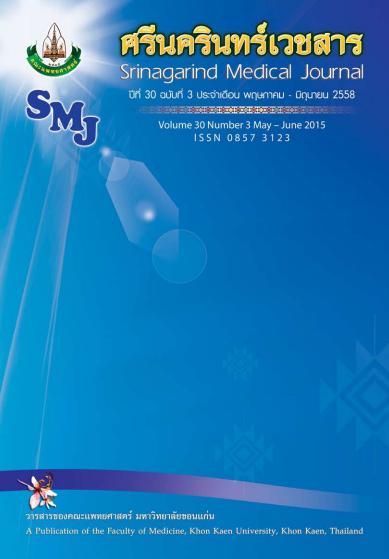Quit Smoking Behavior of Current Smokers: A Case Study at Pharsai Clinic, Ubon Ratchathani University
Keywords:
Quit Smoking Behavior, Pharsai Clinic, Smoking CessationAbstract
Background and objectives: Since February 2013, a cessation clinic called “Pharsai Clinic” has been opened for the clients living closed to Ubon Ratchathani University (UBU). The clinic serves mostly UBU staff and students seeking to quit smoking. The duration criteria to monitor the smoking cessation are 6-months. The study aims to evaluate quit smoking behavior of the smokers who completely underwent 6-month cessation period from February to July 2013.
Methods: It is a cross-sectional descriptive study. Totally there were 53 participants qualified into the study. They underwent a screening test for smoking cessation. A questionnaire paper was used to collect client data including, demographic information (11 items), history of cigarette smoking (6 items), and smoking cessation strategies (34 items). Each participant received an individual cessation strategy based on his background information. The quit program was divided into 3 hospital visits; 0, 3, 6-month periods. All data was analyzed via both descriptive (e.g., Mean S.D, frequency, percentage) and analytical (e.g., Chi-square test) statistics.
Results: All 53 participants were males, aged between 41 and 59 yearly (41.50%), occasionally drink alcohol (50.90%). The current smokers were 100%, had a history of smoking less than 5 years (29.60%), smoked 1 to 10 rolls of cigarettes per day (74%), were ready to quit (77.4%), mildly addicted (56.6%), received drug therapy for cessation (58.3%), mostly were mouthwashes (26.4%). After the completion of 6-month periods, only 13 smokers were able to quit smoking (48.14 %). Noticeably, only three factors including, the first smoking after waking up, levels of readiness to quit smoking, and cessation strategies were statistically significantly related to quit smoking behavior (p =.002, <0.001, <.001, consecutively)
Conclusion: The Cessation Clinic at Ubon Ratchathani University has been opened for smoking cessation counseling service. Only 53 participants enrolled into the program. The successful quitters were 24.52%. The factors including, first smoking after waking up, levels of readiness to quit smoking, and cessation strategies were related to quit smoking behavior. All data would be applied for a further cessation strategy development.




